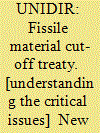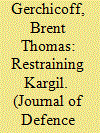| Srl | Item |
| 1 |
ID:
099030


|
|
|
|
|
| Publication |
New York, United Nations, 2010.
|
| Description |
xiv, 129p.
|
| Series |
UNIDIR/2010/4
|
|
|
|
|
|
|
|
|
|
|
|
Copies: C:1/I:0,R:0,Q:0
Circulation
| Accession# | Call# | Current Location | Status | Policy | Location |
| 055254 | 355.825119/UNI 055254 | Main | On Shelf | General | |
|
|
|
|
| 2 |
ID:
121078


|
|
|
|
|
| Publication |
2013.
|
| Summary/Abstract |
The debate surrounding the stability of nuclear weapons has been a critical issue for the last half century. On the one hand, realists like Kenneth Waltz argue that the proliferation of nuclear weapons will foster greater stability due to the intrinsic deterrent logic associated with these weapons. The nuclear pessimists, on the other hand, argue that the accidental use of nuclear weapons and unstable regime types are a greater concern for the outbreak of nuclear war. With no clear consensus in sight, this article argues that the nuclear deterrent logic is the most compelling explanation for the lack of full-scale war. It takes as its case study the 1999 Indo- Pakistani conflict at Dras-Kargil. This crucial case study demonstrates that the caution and, therefore, deterrent effects associated with nuclear weapons in the Indo-Pakistan rivalry confirms that caution and stability result from the introduction of these weapons on the Sub-continent.
|
|
|
|
|
|
|
|
|
|
|
|
|
|
|
|
| 3 |
ID:
129432


|
|
|
|
|
| Publication |
2014.
|
| Summary/Abstract |
Tenancy reform has long remained an unfinished agenda in Indian agriculture. Although, all the States passed their respective tenancy legislations after independence, except for a few States like West Bengal,
most of the States have failed in achieving their goals of efficient and equitable use of agricultural land. This has been recognised in the Draft National Land Reform Policy (DNLRP) which was put in public
domain for discussion purposes and comments on 24th July, 2013 by the Department of Land Resources, Ministry of Rural Development, Government of India. Though the issue of tenancy reform was almost
relegated to the history, at least in the policy arena, the DNLRP has again enthused some interest on the issue. In light of the DNLRP, the present paper revisits the long pending issue of tenancy reforms in India.The draft of NLRP contains 18 chapters excluding the introduction. Each of the chapters deals with a critical issue. Some of the major issues that the DNLRP dealt with, among others, are i) protection of
lands belonging to Schedule Castes, Schedule Tribes and other Marginalised Communities, ii) Land Rights to Women, iii) Tenancy and iv) Modernization of land records. Chapter 10 of the DNLRP
presents the recommendations related to tenancy.
|
|
|
|
|
|
|
|
|
|
|
|
|
|
|
|